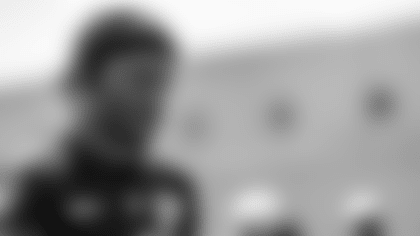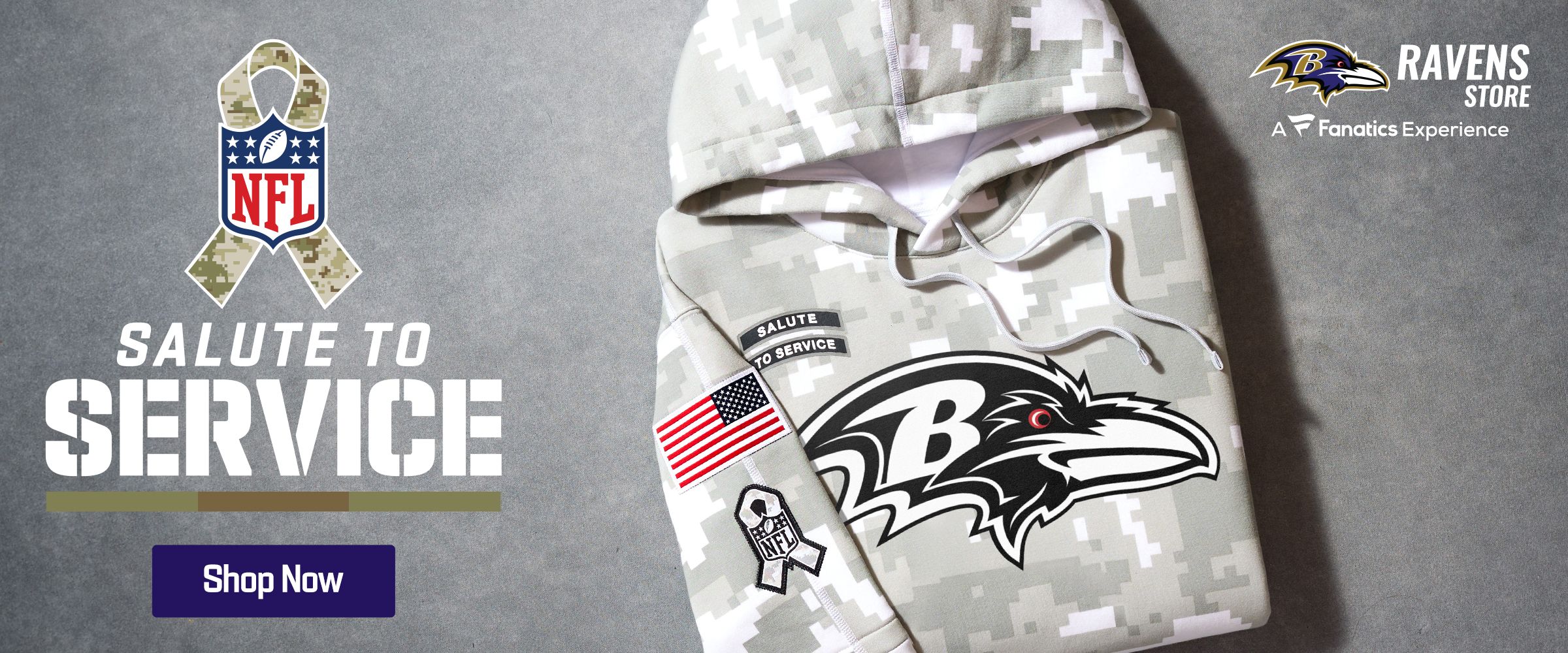On June 11, 2008, Jonathan Ogden walked into new Head Coach John Harbaugh’s office and told him he was retiring. Harbaugh shook Ogden's hand, buried his head in his chest, and fake cried.
One of the first challenges Harbaugh had to face after being hired as the Ravens' head coach was the retirement of a Hall of Famer. That kicked off the first offensive line rebuild during Harbaugh's tenure. Now the Ravens are preparing for another this offseason.
With Kevin Zeitler headed to Detroit, Morgan Moses traded to the Jets, and John Simpson also going to New York, Baltimore is faced with filling three starting offensive line positions – right tackle and both guard spots.
The Ravens knew this was coming. Harbaugh spoke with General Manager Eric DeCosta shortly after last season ended about undergoing an offensive line rebuild. Their takeaway: "We've done this before."
"I feel confident that we can do it, but we have to do it," Harbaugh said at the Combine. "It's of upmost importance. When you have a good offensive line, it paves the way for a good offense. … It's priority No. 1."
Returning are Pro Bowler Tyler Linderbaum, who has quickly become one of the league's best centers, and left tackle Ronnie Stanley, who the Ravens are hoping can stay healthy and get back to his previously dominant form.
As of now, the guard spots look like a battle between Ben Cleveland, Sala Aumavae-Laulu, and Andrew Vorhees, and right tackle will be Daniel Faalele or sixth man Patrick Mekari.
The Ravens could still sign a veteran and will likely use multiple draft picks (they have nine) on offensive linemen, with those picked on Days 1 or 2 likely competing for a starting spot from the jump.
"It is a good draft for offensive linemen. The timing is good there," Harbaugh said. "So we'll have a chance, I'm quite sure, to add some guys in the draft."
Here's how the Ravens rebuilt their offensive line the previous times under Harbaugh, and takeaways from each process:

2008 – 2012
Filling Ogden's shoes at left tackle proved most difficult. The Ravens didn't have the luxury of drafting his heir early in 2008 because they first had to get a quarterback (Flacco). Baltimore took shots on a pair of mid-round linemen, Oniel Cousins and David Hale, in the third and fourth rounds but neither became full-time starters.
The good news was the Ravens had a trio of offensive linemen from the 2007 draft who were ready to step into larger roles – first-rounder Ben Grubbs, third rounder Marshal Yanda, and supplemental draft pickup Jared Gaither.
Gaither had the especially tall task of stepping in for Ogden as a rookie and lasted a year-and-a-half in the role. Grubbs was an anchor at left guard for the next four seasons, and Yanda played guard and tackle (wherever needed), establishing himself as a perennial Pro Bowler.
Baltimore got its proven center in 2009, signing free-agent veteran Matt Birk following the retirement of Matt Flynn and free-agent departure of Jason Brown. Birk solidified the unit for years to come.
The Ravens took their first-round tackle in 2009 with Michael Oher. But while the movie based on his life was called "The Blind Side," Oher spent most of his career at right tackle.
Baltimore ultimately went the free-agent route at left tackle, signing veteran Bryant McKinnie before the 2011 season. He also took over for Oher at left tackle in the 2012 playoffs, which moved Oher to right tackle and 2012 second-round pick Kelechi Osemele to guard. That shuffle unlocked the whole unit, making the puzzle come together to keep Flacco upright for his torrid Super Bowl run.
Takeaways:
- Finding a franchise left tackle is tough, even in the late first round
- Drafting and developing guards is typically a good solution
- Need an anchor at center

2013 – 2016
Still trying to find their long-term left tackle solution, the Ravens traded for veteran Eugene Monroe midway through the 2013 season. He finished that year strong, earning a five-year, $37.5 million deal the following offseason. However, injuries limited him to just 17 games total after inking that deal, and Ravens released him in 2016. Baltimore was forced to lean on undrafted tackle James Hurst.
The Ravens let Oher walk in free agency following the 2013 season and put their faith in right tackle Ricky Wagner, a fifth-round pick the year before. Wagner excelled, starting nearly every game for the next three years before inking a big deal with the Lions.
The Ravens' other youth gamble didn't work out as well, as 2012 fourth-round pick Gino Gradkowski struggled to step into Birk's shoes after the veteran retired. Baltimore traded for center Jeremy Zuttah a year later and he started most of the games over the next three seasons. Fifth-round pick John Urschel also looked ready to step into the role but retired early to focus on mathematics.
Takeaways:
- Middle-round young players stepping into starting roles is hit or miss
- Free agent left tackles are expensive and it's especially costly when they don't work out
- High-quality centers make a big difference

2016 – 2019
The Ravens found their left tackle, grabbing Stanley with the sixth-overall pick. He started from Day 1 and quickly emerged as one of the league's best at his position.
Baltimore also drafted Alex Lewis in the fourth round and he won the starting left guard job as a rookie. Injuries ultimately limited Lewis to just 20 games in his three years with the Ravens, however.
Ryan Jensen, a sixth-round pick in 2014, took over as the starting center in 2017 and flourished, earning a big-time deal with the Tampa Bay Buccaneers, where he went on to win a Super Bowl and go to a Pro Bowl. With Jensen gone, the Ravens turned to undrafted Matt Skura and then Mekari.
The Ravens patched right tackle with veteran Austin Howard in 2017, replacing Wagner, before drafting the replacement, Orlando Brown Jr., in the third round in 2018. Brown became a starter seven games into his rookie season and never looked back en route to becoming a Pro Bowler.
Baltimore picked Bradley Bozeman in the sixth round in 2018 and handed him the left guard keys in 2019, where he excelled for two years before sliding back to his natural center position.
The Ravens had the best offensive line in the league and three Pro Bowlers (Stanley, Brown, Yanda) in 2019, paving the way for Lamar Jackson's first MVP season.
Takeaways:
- Maintain a pipeline of Day 3 offensive linemen who can develop into reliable starters
- Even a rookie drafted in the middle rounds can start in Year 1 and have success
- A top-notch offensive tackle duo can unlock an offense

2020 – 2023
Yanda retired following the 2019 season and the Ravens struggled to replace him. Then Stanley suffered a major ankle injury days after inking his mega five-year extension, which flipped Brown to left tackle, where he felt he belonged all along and resulted in his trade request the following offseason.
The Ravens solved the guard problem in 2021 by signing Zeitler, who was one of their better value signings of the past decade.
Tackle was a tougher riddle. Stanley only made it through one game before having to go back on the shelf, which forced free-agent addition Alejandro Villanueva back to left tackle after he was signed to play right. The Ravens addressed the tackle issue in 2022 by inking another veteran in Morgan Moses, who was also a strong addition for the past two years, but Stanley's injuries have left the line in a lurch the past several years.
After years of late-round or undrafted centers, Baltimore grabbed its anchor for years to come with Linderbaum in the first round of the 2022 draft. He now stands as the literal center of the Ravens' next rebuild.
At left guard, the Ravens continued with their draft-and-develop strategy, with Bozeman, 2019 fourth-round pick Ben Powers, and 2020 third-round pick Tyre Phillips getting starts. Phillips was eventually traded, but Powers was a hit who started all 17 games in 2022 before leaving for a lucrative deal in Denver. His replacement, Simpson, was another veteran signing that worked out.
The Ravens again had one of the best offensive lines in the NFL (No. 5, per Pro Football Focus) in 2023, but four starters were 30+ years old and it was going to be costly to keep them. Thus, Baltimore made the decision to start the process again.
Takeaways:
- Draft and develop guards
- Maintain quality depth at offensive tackle
- Right player, right price veterans are hit or miss



















